The 2011 MacBook Air (11 & 13-inch): Thoroughly Reviewed
by Anand Lal Shimpi on July 28, 2011 3:25 AM EST- Posted in
- Apple
- Mac
- Intel
- Sandy Bridge
- MacBook Air
- Laptops
CPU Performance: A Huge Upgrade
I've got an expanded test suite here courtesy of the testing I did for our Lion review. As I mentioned in our Lion review, performance hasn't changed between Snow Leopard and Lion for the most part so the older data in these benchmarks is still quite valid.
Adobe Photoshop CS4
The old Air was not very good for those doing a lot of photo work. You could manage, and I definitely did, but it was painful. The story is completely different with the new MacBook Air however.
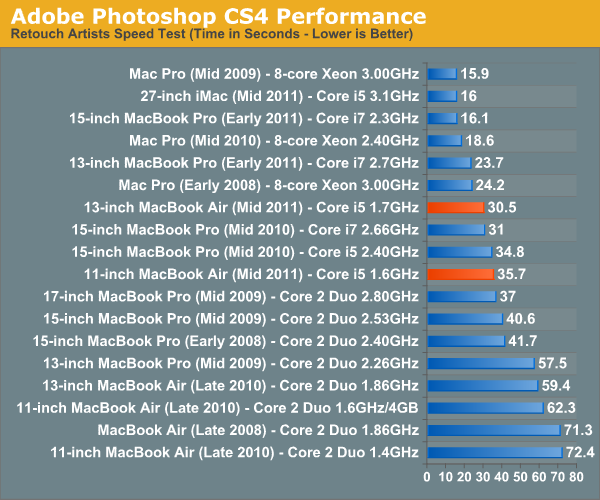
While the 2011 Macbook Pro is still considerably faster, completing our CS4 test in just over half the time as the 13-inch Air, these machines are competitive with last year's MBP. Remember the 2010 MacBook Pro only had two Arrandale cores and these Airs have lower clocked, but higher performing Sandy Bridge cores. Part of the performance advantage is the integrated SSD, whereas those older Macs didn't come with one by default. But most of the time these chips are running near their max turbo frequencies under load, which really helps narrow the performance gap between them and their 2010 professional counterparts.
If you have anything older than a 2010 MacBook Pro, these new Airs will actually be an upgrade for you.
Cinebench: Single & Multithreaded Performance
The old Air just wasn't that great of a performer. They were good enough if you didn't do much with your machine, but for those who lived on the bleeding edge they performed like a 3 year old MacBook Pro.
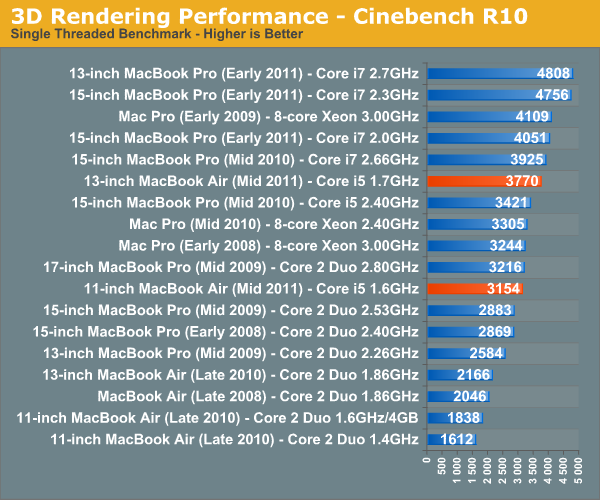
Single threaded performance on the new Air is much better than before thanks to turbo boost. The 11-inch MBA is 71% faster than the upgraded 11 from last year, that's more than noticeable in real world usage. The 13-inch MacBook Air enjoys a similar advantage over its predecessor.

Where things get even more ridiculous is in multithreaded performance:
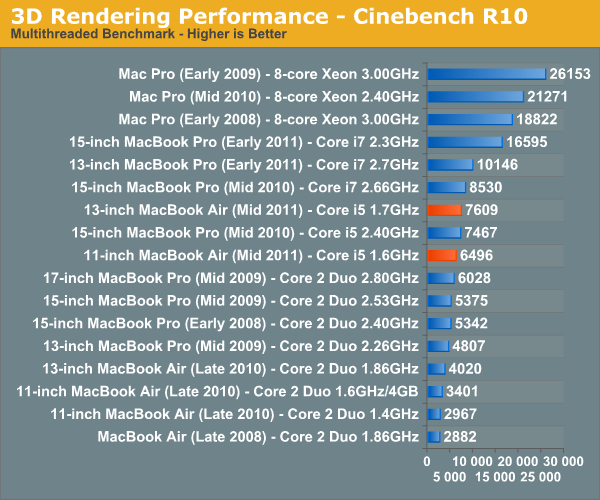
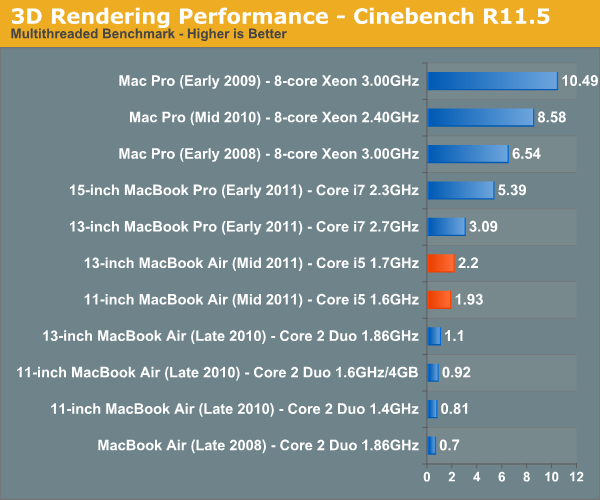
The single threaded performance of the new 11-inch MacBook Air is actually higher than the multithread performance of last year's model. Thanks to Hyper Threading and better performance per core you get around twice the performance of last year's models. Again the Air still isn't as good as the new quad-core MacBook Pros, but if you've got a machine from 2008 the new 13-inch MBA will actually be a performance upgrade (and a more portable machine).
Boot Performance
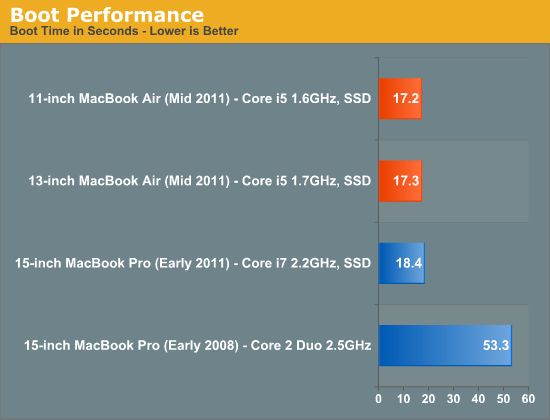
Boot time on these machines is great thanks to Apple's minimalist EFI and their SSDs. I will mention that the MacBook Air used to wake from sleep almost instantly however as of several OS revisions ago there seems to be a noticeable lag before I get a usable mouse cursor. I don't remember this being the case when the MacBook Air first came out and it's no different in Lion.
iMovie 11 Performance
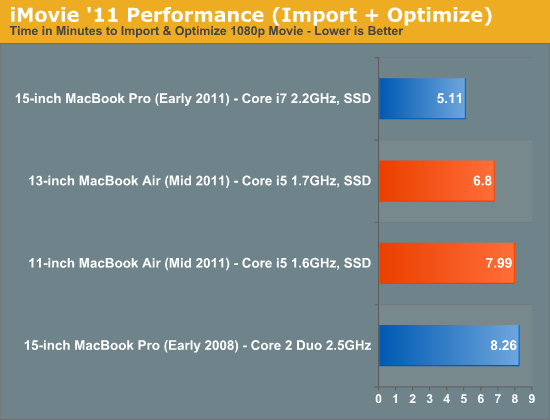
If you're going to be doing any video transcoding work you're going to want to upgrade the 11-inch MacBook Air's CPU. While it's much quicker than it used to be, the 1.6GHz Core i5 takes 17% longer to finish our iMovie import script than the 1.7GHz i5 in the 13-inch MacBook Air.
Exporting is a far bigger issue on these parts. Again the new systems are much faster than the old ones but if you're serious about video transcoding you should probably have a MacBook Pro.
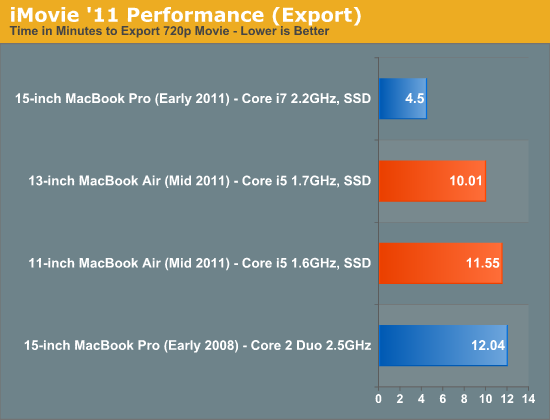
I'd also like to take this opportunity to say that it's absolutely ridiculous that Apple still doesn't support QuickSync in iMovie. We'd see far better performance from all Sandy Bridge equipped Macs if Apple would just take advantage of QuickSync. The silicon is there, it just needs to be used.
iPhoto 12MP RAW Import
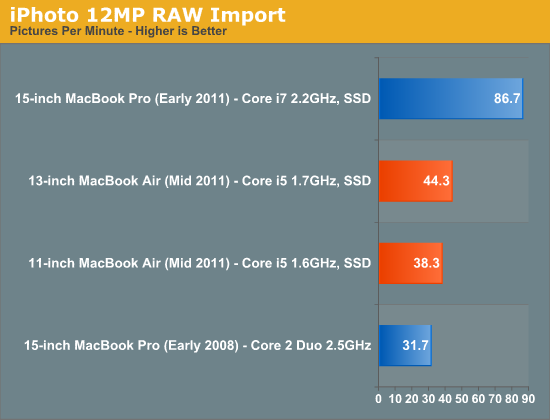
Here the new Airs do very well, but the 15-inch MacBook Pro is still around 2x the speed.
Adobe Lightroom 3
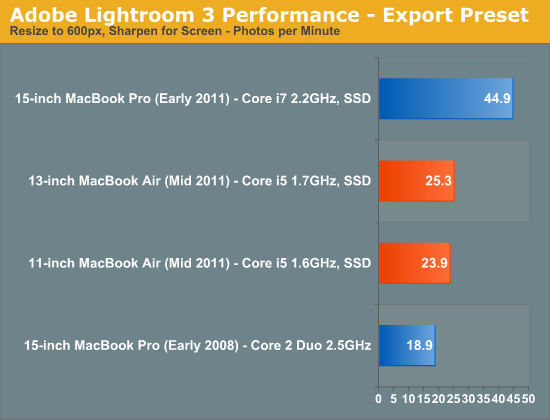
Final Cut Pro X
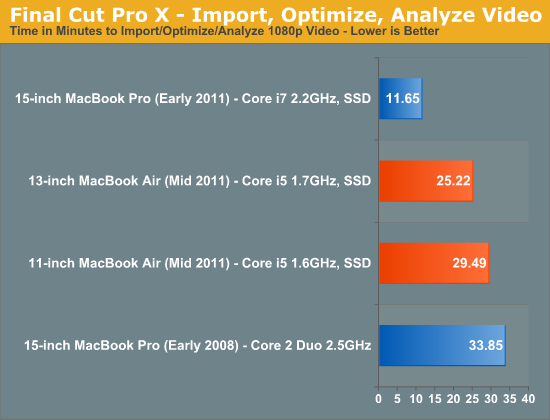
The trend continues. These new machines are faster than a 15-inch MacBook Pro from early 2008, but are no match for the new 2011 15-inch MacBook Pro. If you're going to do a lot of video encoding there's no replacement for more cores.










103 Comments
View All Comments
tipoo - Thursday, July 28, 2011 - link
I'd like to know too, in fact I think a decibel reading for laptop reviews would be great.solatic - Thursday, July 28, 2011 - link
"... [It's] easy to imagine a future where laptops become a lot more like the new Air and shift to a couple high bandwidth ports instead of numerous lower bandwidth connections."I agree in a sense, but I very much disagree with the manner of your idea.
Getting rid of low-bandwidth ports on laptops is stupid because these low-bandwidth ports are industry standards. The standard display jack for projectors everywhere, from business rooms to classrooms etc., is VGA. Good old VGA from the 90's which was never displaced by HDMI or DVI despite their ubiquity and technological superiority. Why is irrelevant, but my point is that I can't tell you how many people I've seen with Apple laptops who time and again have asked to borrow my machine with its VGA port because they can't find their VGA dongle or forgot it at home/the office.
VGA, RJ-45, USB - we don't use these jacks because of how much bandwidth they move but because we know we will encounter devices in the field that will use them.
What you really want, Anand, is a docking station. Lenovo/IBM has/did made/make them for some time for the Thinkpad line. You come to the office, slide your laptop in, and boom - the docking connector is a high bandwidth connector that connects you to network, display, audio, interface, etc.
The only real problem with docking stations is that they're either proprietary (the Thinkpad ones) or they're too slow for higher-bandwidth applications (USB docking stations). If you see a future in Thunderbolt docking station-type devices - like the Thunderbolt display - then this is a good thing. The Thunderbolt display can now be used by any Apple computer with a Thunderbolt port - whereas Lenovo has to manufacture different docking stations for the X and T series and these docking stations can't be used with Toshibas, Apples, Dells, etc.
But to propose getting rid of VGA and RJ-45 ports now is not something I can agree with. Put Thunderbolt on new machines, make Thunderbolt projectors etc., wait for them to saturate the market - and then, only then, does it really make sense to get rid of these slower ports.
repoman27 - Friday, July 29, 2011 - link
It certainly makes sense to ditch VGA on a product like the MacBook Air, since a VGA port is too large to physically fit inside it. And it makes sense on all other laptops since most people would rather have 10 more mins of battery life all the time than a VGA port on the odd occasion that they need one. I propose that those who own archaic video devices lacking a digital interface buy a $5 adapter and leave it attached to the device, that way people with modern notebooks can connect to them without issue.The lack of a wired Ethernet port on the Airs is also due to its ultra slim profile, but it amazes me how many people I know that have no idea that they can plug their laptops into a wired network and get far better throughput. As long as WiFi offers more bandwidth than most people's ISPs, I think you can kiss that RJ45 port goodbye without upsetting too many folks.
Wolfpup - Thursday, July 28, 2011 - link
Great reviews like this are why I love this site. Super thorough and interesting on the tech, and, interesting thoughts on practical stuff too.I prefer Windows, but have been wanting a secondary Mac for a while for the heck of it. I'm SUPER torn on what to get...
The 11.6" almost seems perfect, since I can throw it in my bag with my main notebook and be okay-stick it on my desk without too much issue. But...if I ever actually used it as my primary system, the 13.3" one would be a lot more usable. And at THAT point, the 13.3" Pro is a lot more usable, and at THAT point, the 15.4" Pro isn't much larger, and completely destroys it, and of course could be my main system...
Sooooo you see my dilemma ;)
Heh...maybe I should just go with the 11 since I'm not planning on using it as my primary.
name99 - Thursday, July 28, 2011 - link
"All three parts support Hyper Threading and Quick Sync, although the latter remains mostly unused in OS X. "Quick Sync is used by iChat HD, is it not?
The other natural client for it would be AirPlay. My guess is that, come iOS5 in September, we will see AirPlay on SNB macs beefed up to be able to stream any content (not just h264) to AirPlay devices by doing the transcode transparently on Quick Sync.
The third obvious sort of client would be a library that third party apps like HandBrake would get to. What's the currents situation now --- do you need to be root to get to QuickSync or can any app use it?
My guess is that we are facing the constant problem of new "weird" hardware --- it never comes virtualizable in the first iteration, which means that there is ALWAYS the problem of how to mediate access. And we generally see the same pattern
(a) A single app that is allowed access.
(b) Some sort of library that provides its own mechanisms for mediating access.
(c) The hardware (FINALLY) becomes virtualizable.
Apple is currently at step (a). Getting to (b) is never completely trivial (in spite of the claims of no-nothings in blog comments), at least if you want to do the job properly. You have to consider questions like --- do you use a reservation model, or do you simply provide notifications when you want to grab the hardware away from a user? How easy is it juggle state and provide something that looks virtualized? etc etc.
And there are ALWAYS, at least in the first gen, weird hardware interlocks that make life more difficult. I know nothing about QuickSync but I would not be surprised if, for example, using it has implications for using the main GPU, meaning one more thing that has to be balanced in the attempt to make it used more generally.
Can someone from the Windows world (who understands these issues, and has something more useful to say than "Macs suck") tell us how QuickSync is used in the MS world? Does MS provide a general purpose library, and how does the mediation model for that library work?
name99 - Thursday, July 28, 2011 - link
Oops, my bad. The Macbook Airs apparently do not have an HD camera because it can't fit in the available depth of the thin screen. So no iChat HD on these models.I think the rest of what I said, especially about AirPlay, still stands.
rootheday - Friday, July 29, 2011 - link
The sharing/scheduling of the GPU enginers by multiple client applications on Windows is mediated by the OS as part of the WDDM driver model dating back to Windows Vista - QuickSync is no exception. This means that we are already at c) on your hierarchy on Windows with multiple client applications able to easily share the GPU for encoding.Moreover, Intel has a library already for this - see http://software.intel.com/en-us/articles/media/
The media sdk library provides an API that applications can use to perform encoding and decoding. If run on a system with QuickSync hardware support and drivers, the work is routed to the GPU. If not, the library offers a CPU fall back path. This allows ISVs to write their application once - it will just run faster on Sandybridge systems.
I don't know enough about Apple OS and graphics driver model to comment on how hard it would be for Apple to get to the same level.
jvmxtra - Thursday, July 28, 2011 - link
Thanks for the great review. I throughly enjoyed your review but I feel like one thing is missing.In fact, for a laptop review, I really want all the sites to start devoting some time and even creating a method to measure the heat that laptop brings on. We have to create some type of way to measure(benchmark?) the heat index as I feel like how hot laptop gets under certain circumstance is critical factor.
In fact, I had to trade in my 15 inch mbp since it was just getting too hot.
tipoo - Thursday, July 28, 2011 - link
The thermals and power consumption page is a start.name99 - Thursday, July 28, 2011 - link
"This is what Thunderbolt was meant to do. All we need now is widespread adoption, more accessories and a standard for external GPU form factors."AND device manufacturers who are not idiots. In particular, where are the TB hubs?
The device the market obviously wants is a TB to USB3 hub ---
two TB ports, four USB3 ports --- and yet we still have not seen this.
I'm sorry, Sonnet, but this would be VASTLY more useful than your EN and FW800 bridges.
WTF is going on?